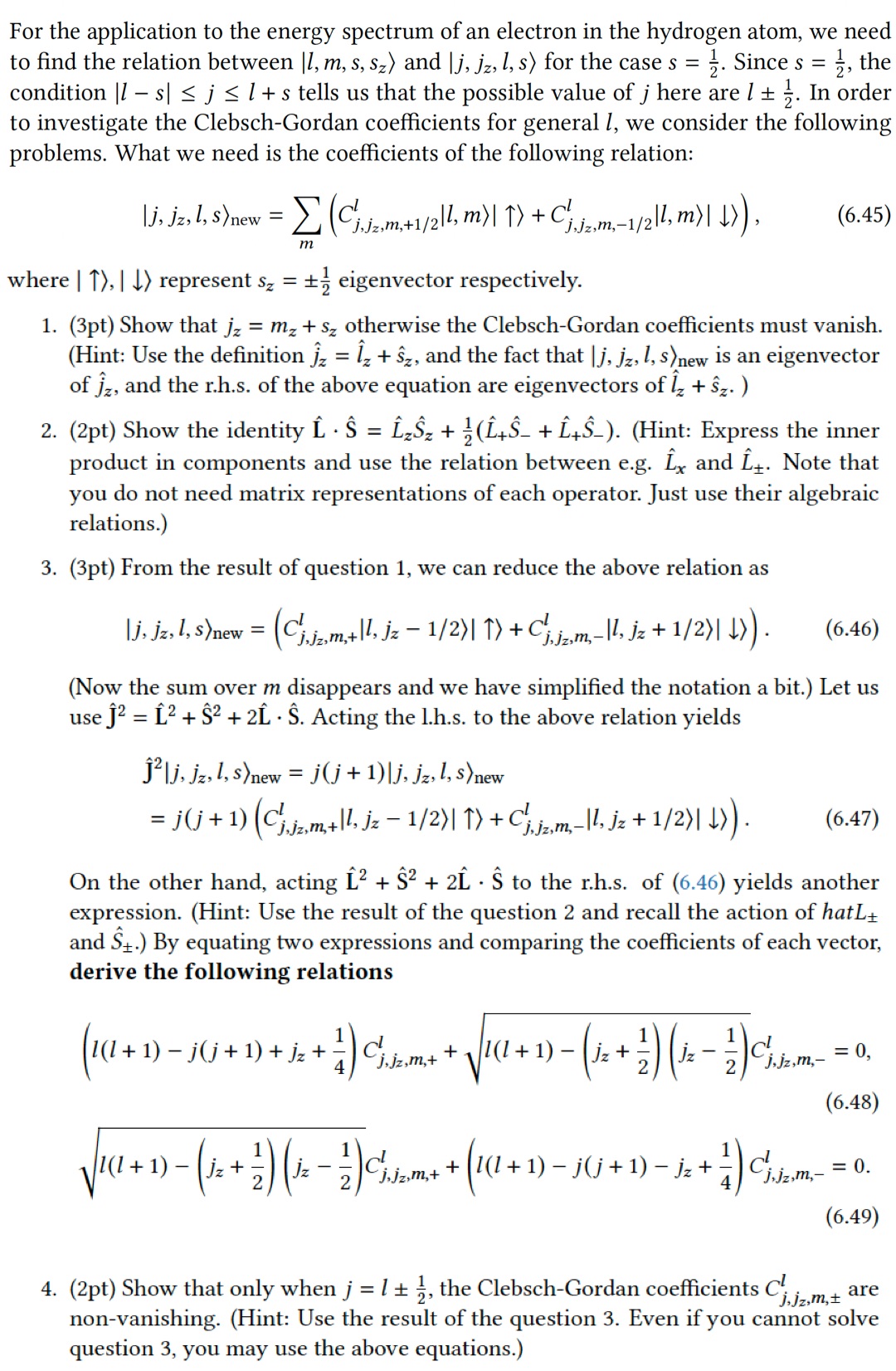Answered step by step
Verified Expert Solution
Question
1 Approved Answer
For the application to the energy spectrum of an electron in the hydrogen atom, we need to find the relation between |l, m, s,

For the application to the energy spectrum of an electron in the hydrogen atom, we need to find the relation between |l, m, s, sz) and \j, jz, l, s) for the cases = = . Since s = , the condition || - s| j 1 + s tells us that the possible value of j here are 1 1. In order to investigate the Clebsch-Gordan coefficients for general l, we consider the following problems. What we need is the coefficients of the following relation: |j, jz, L, S) new = (cj, jz,m,+1/2|l, m)| ) + C'), jz,m,1/2|l, m) | )), (6.45) m where | ), | ) represent s = eigenvector respectively. 1. (3pt) Show that j = m + s otherwise the Clebsch-Gordan coefficients must vanish. (Hint: Use the definition = z + sz, and the fact that |j, jz, l, s) new is an eigenvector of jz, and the r.h.s. of the above equation are eigenvectors of + z. ) 2. (2pt) Show the identity = zz + ( + _). (Hint: Express the inner product in components and use the relation between e.g. x and L. Note that you do not need matrix representations of each operator. Just use their algebraic relations.) 3. (3pt) From the result of question 1, we can reduce the above relation as l, |j, jz, 1, s)new = (Cj.jz,m,+1, jz 1/2)| ) + Cj, jz.m,-|l, jz + 1/2)| >). (6.46) (Now the sum over m disappears and we have simplified the notation a bit.) Let us use = 12 ++2L . Acting the l.h.s. to the above relation yields |j, jz, l, s)new = j(j + 1)|j, jz, l, s)new = j(j + 1) (Cjz,m,+|l, jz 1/2)| ) +Cjz.m.-|l, jz + 1/2)| )). - . (6.47) On the other hand, acting + + 2 to the r.h.s. of (6.46) yields another expression. (Hint: Use the result of the question 2 and recall the action of hatL+ and St.) By equating two expressions and comparing the coefficients of each vector, derive the following relations (1(1 + 1) j Gj - - j(j + 1) + jz+ 41 C j,jz,m,+ + 1(1+1) jz + - 2 j.jz,m,- = 0, (6.48) 1 ( z += ) (1 1 ) / Jam + + (1 (1 + 1) - j,jz,m,+ j(j + 1) jz + +14) = = 0. (x+f)-(x+1)1) (6.49) 2' j,jz,m, are 4. (2pt) Show that only when j = 11, the Clebsch-Gordan coefficients C non-vanishing. (Hint: Use the result of the question 3. Even if you cannot solve question 3, you may use the above equations.)
Step by Step Solution
There are 3 Steps involved in it
Step: 1

Get Instant Access to Expert-Tailored Solutions
See step-by-step solutions with expert insights and AI powered tools for academic success
Step: 2

Step: 3

Ace Your Homework with AI
Get the answers you need in no time with our AI-driven, step-by-step assistance
Get Started


